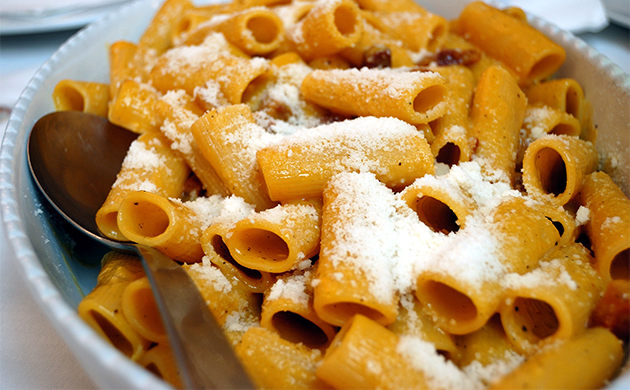
Admiring immortal artwork is a must for anyone visiting Rome, but tucking into local delicacies is equally important if you want to discover the city’s unique flavors and unearth its history. Local gastronomy dates as far back as the city’s inception, and while the recipes have certainly evolved, some of the main ingredients have remained constant.
From the Middle Ages to right after WWII, the tendency was to make the best use of whichever ingredients were easiest to get. Frugal is probably what best defines Roman cuisine. Meals have often been made of scraps, yet they never lacked in taste. While the best cuts of meat were the prerogative of wealthy families and the papal court, the unwanted bites such as oxtail, intestines and kidneys, along with easy-to-grow vegetables, legumes and cereals, have always played an important role on the tables of the working class.
Here is a sample of dishes made from many of those ingredients, their history and some of the fine restaurants around the city where you can savor the items today.
Spaghetti alla carbonara
Arguably the most famous Roman dish, spaghetti alla carbonara is a heavenly mix of eggs, crunchy pan-fried pancetta (or guanciale, cured pig cheek), pepper and pecorino cheese. The birth of the carbonara is shrouded in mystery. According to some, it originated from the Abruzzo region and consisted of eggs and cheese. Once the U.S. troops arrived at the end of WWII and added their bacon, Italians promptly replaced it with pancetta. Another school of thought says that the original recipe comes from the Marche region, where eggs were added later to make it more nourishing.
Try it here: Whatever the story, foodies can’t miss Trattoria Da Danilo (13, Via Petrarca) for its authentic carbonara or Roscioli (21, Via dei Giubbonari) for its high-quality ingredients.
Bucatini all’amatriciana
Along with carbonara, amatricana pasta sauce is another outsider, this time hailing from a town called Amatrice. Created with only guanciale and pecorino cheese (today known as gricia), the dish was named amatriciana because Amatrice’s citizens were the first to add tomato in it. When Amatrice farmers used to come to Rome to sell their products, the flavorful sauce was often exchanged, immediately becoming popular in restaurants around the capital.
Try it here: Enjoy a great amatriciana matched with short mezze maniche pasta at Flavio al Velavevodetto (97, Via di Monte Testaccio); Domenico dal 1968 (21, Via Satirico), where a classic version of the dish is prepared; or at Sora Lella (16, Via di Ponte Quattro Capi), a traditional Roman establishment in Tiber Island where the tomato is even hand-smashed.
Tonnarelli cacio e pepe
Vegetarians needn’t despair when visiting Rome. Its cuisine has something for their palates as well. Tonnarelli cacio e pepe is a simple yet delicious first course. A very old dish, the original fare included only egg pasta, pecorino cheese and black pepper — a lot of it. No oil was added. In fact, the secret to the recipe lies in the perfect whipping of well-aged pecorino using a bit of the water leftover from the pasta prep to create a creamy texture that’s seasoned with copious sprinkles of pepper.
Try it here: You will find this dish everywhere, but the must-visit spot is Felice restaurant (29, Via Mastro Giorgio), a place that made the pasta a house specialty.
Coda alla vaccinara
Born in the Regola neighborhood, the area where the vaccinari (ox butchers) used to live, coda alla vaccinara is considered the treat of the quinto quarto (the fifth quarter) of the ox, the remaining portion of the animal after the best cuts were sold to the wealthy. This braised oxtail stew is enriched with lard, tomato sauce, celery and dressed with parsley, garlic, onion, carrot, red wine, salt and pepper.
Try it here: A lengthy and complicated recipe, the best coda alla vaccinara is made at Checchino dal 1887 (30, via di Monte Testaccio), a traditional restaurant near the old slaughterhouse where, allegedly, the dish was accidentally invented in 1890.
Saltimbocca alla romana
One of the most popular Roman dishes, saltimbocca alla romana is made of tender veal medallions covered with prosciutto crudo (raw ham) and sage, and marinated in white wine. While the recipe was probably invented in northern Italy, literary sources from the 19th century placed the dish in Rome’s trattorias.
Try it here: The top places to try it are Armando al Pantheon (31, Salita dei Crescenzi), a stop for authentic local cuisine in the heart of touristy Rome, and Ristorante Hostaria Romana (1, via del Boccaccio), another establishment specializing in customary cuisine.
Photo Courtesy of Angela Corrias

